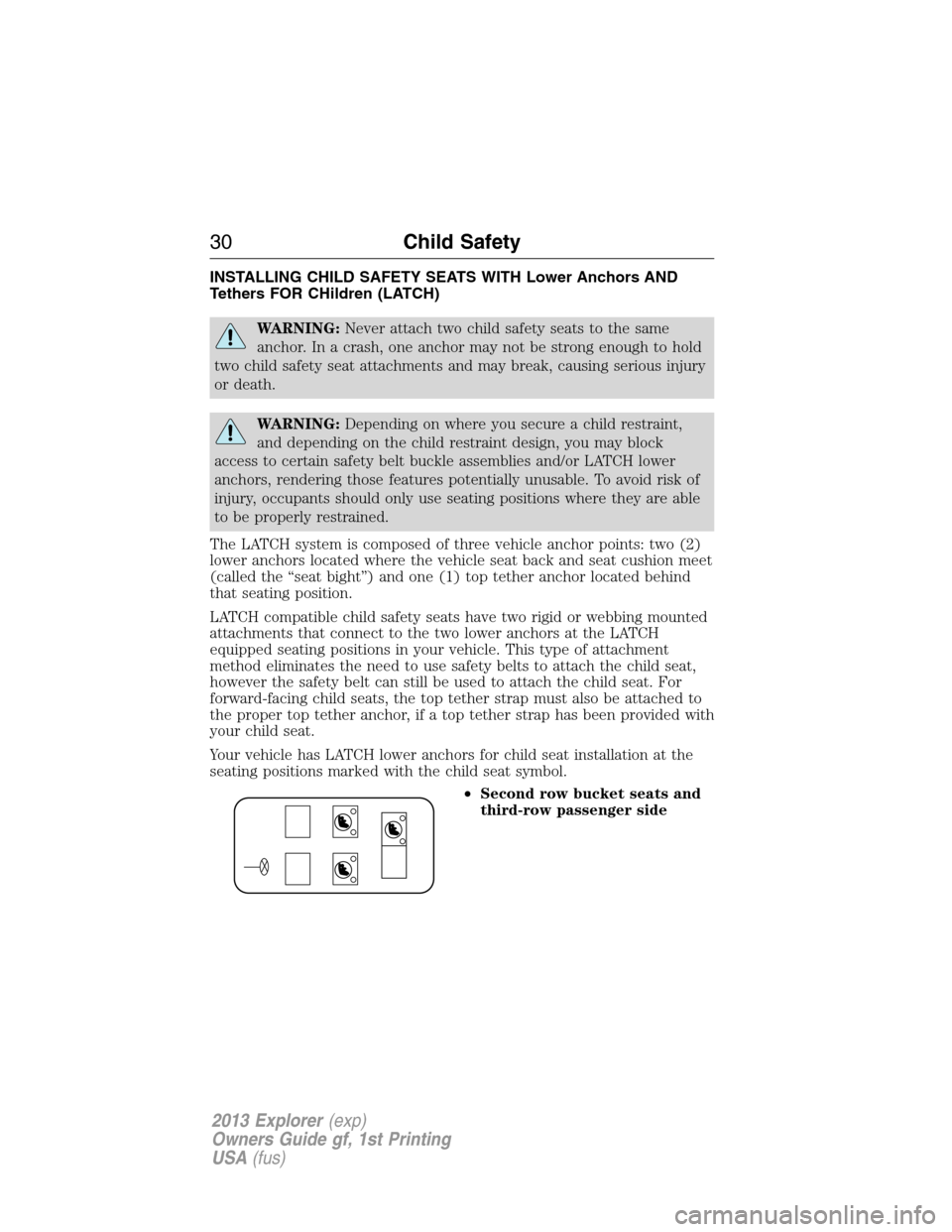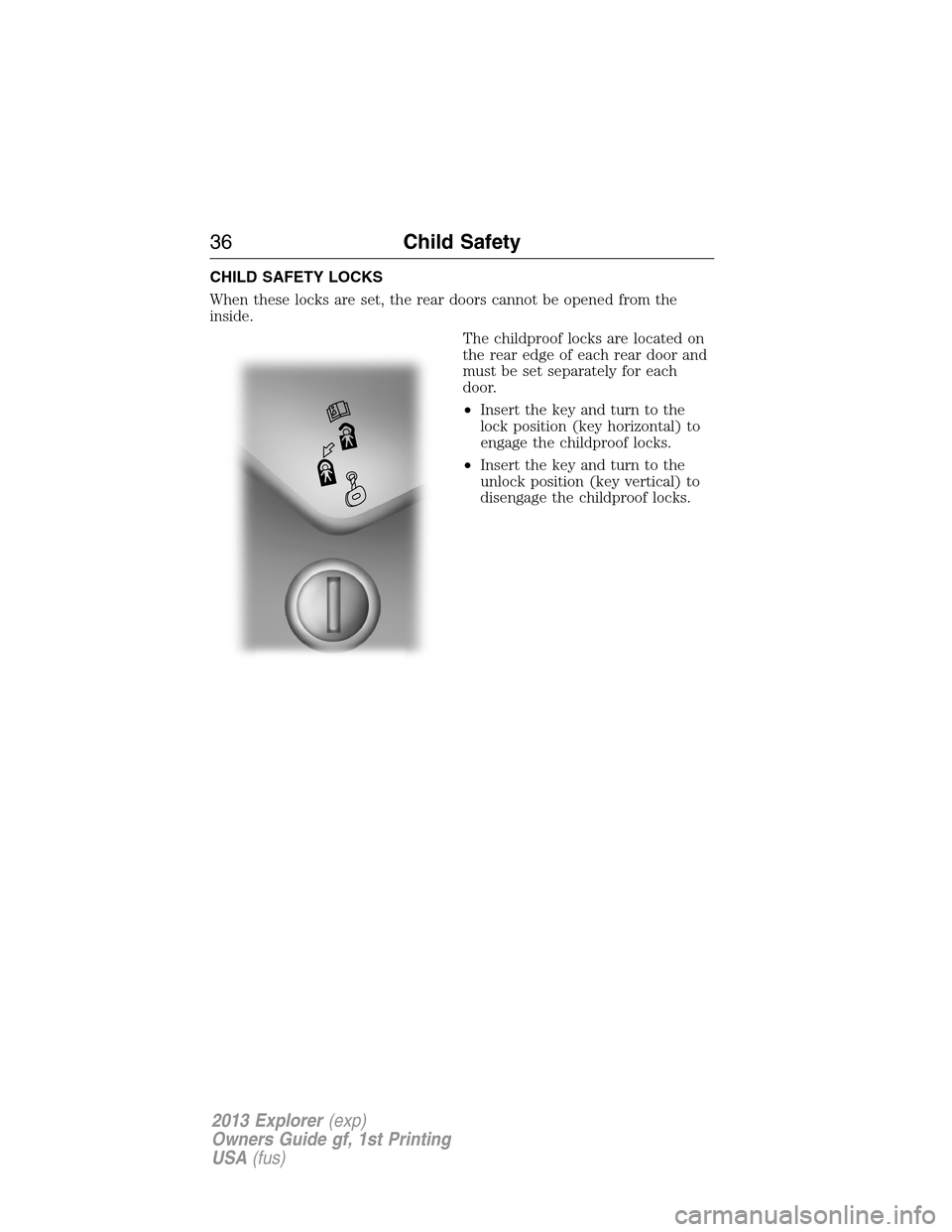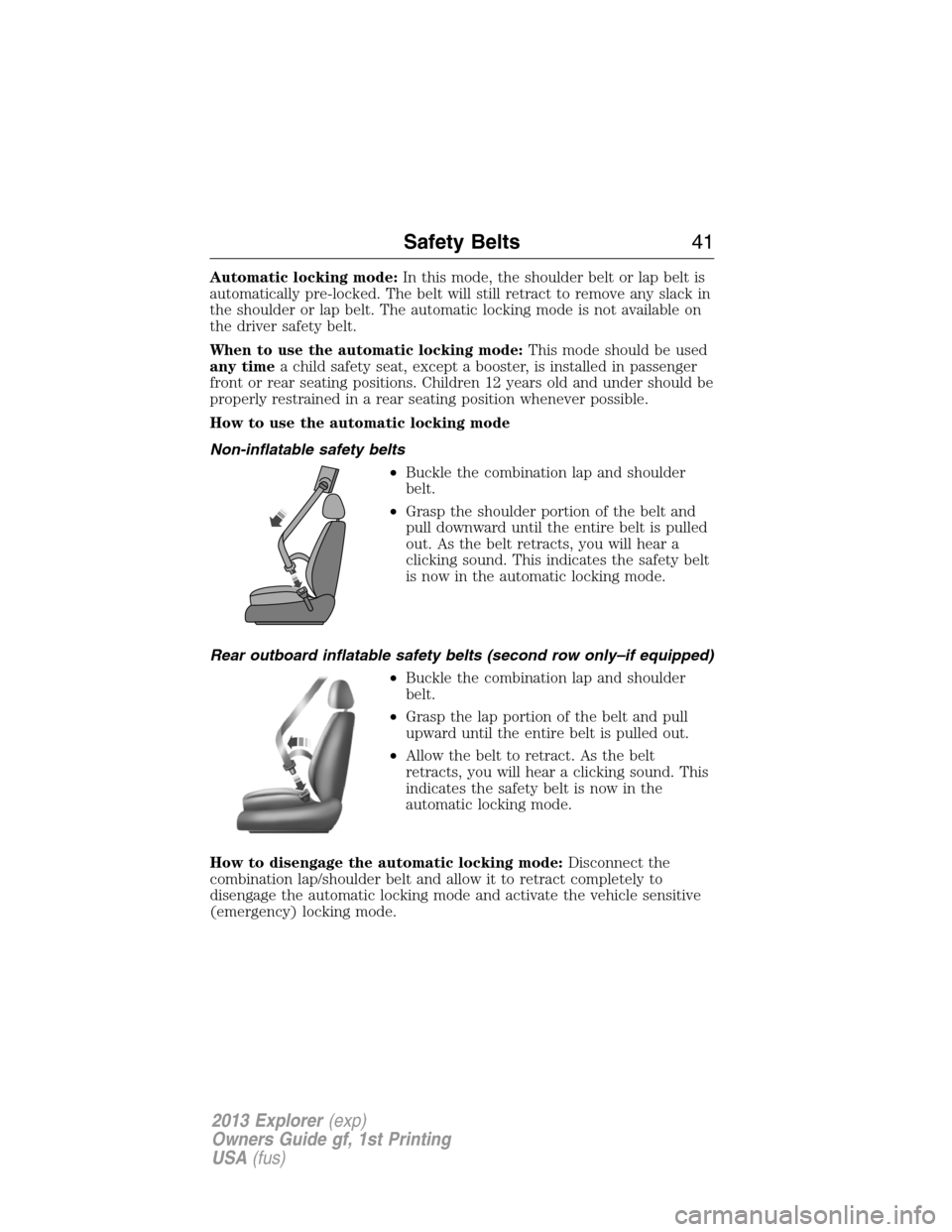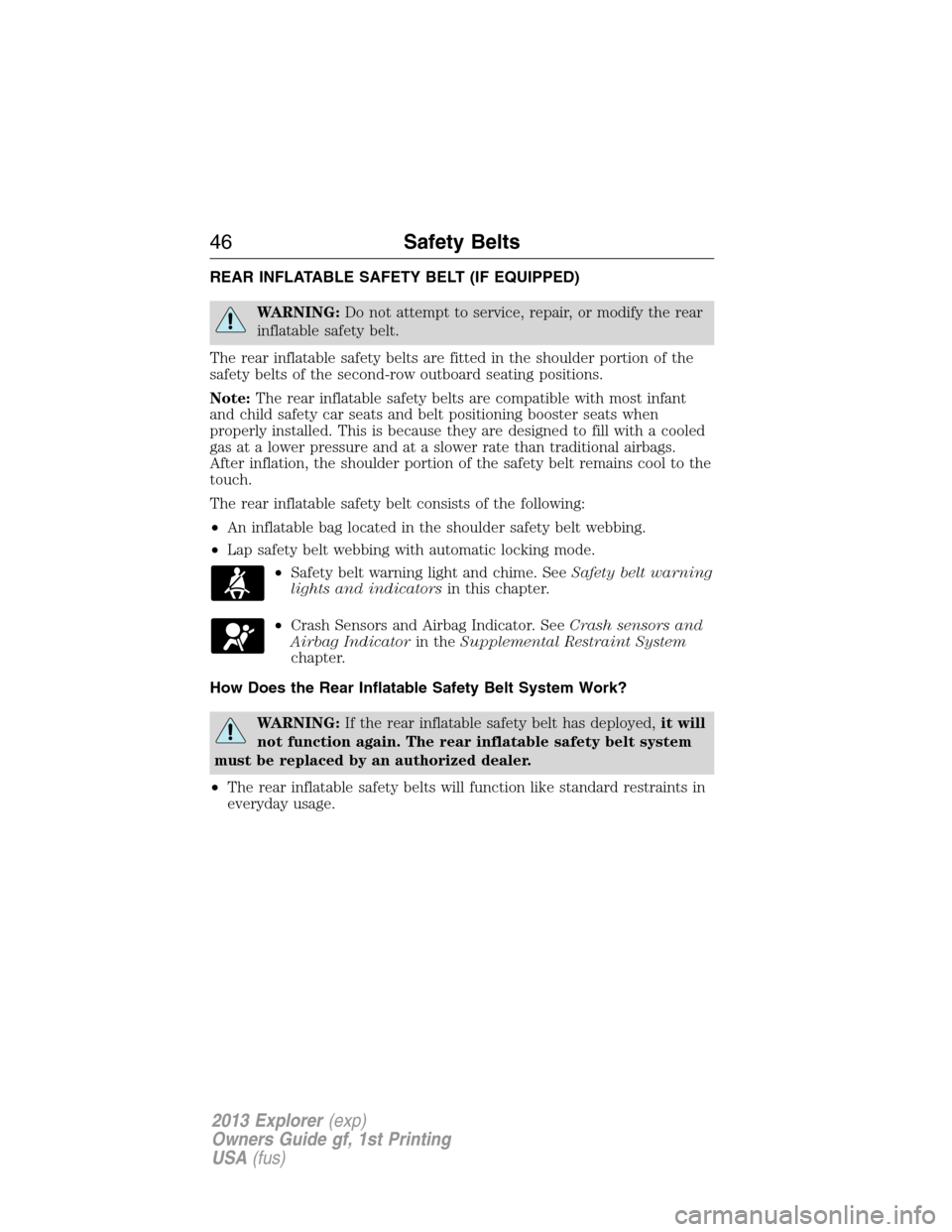2013 FORD EXPLORER lock
[x] Cancel search: lockPage 28 of 576

5. To put the retractor in the automatic locking mode, do the following;
•Standard safety belt: grasp the
shoulder portion of the belt and
pull downward until all of the belt
is pulled out.
•Inflatable safety belt: grasp the lap
portion of the inflatable safety belt
and pull upward until all of the belt
is pulled out.
Note:Unlike the standard safety belt, the inflatable safety belt’s unique
lap portion locks the child seat for installation. The ability for the
shoulder portion of the belt to move freely is normal, even after the lap
belt has been put into the automatic locking mode.
6. Allow the belt to retract to remove slack. The belt will click as it
retracts to indicate it is in the automatic locking mode.
7. Try to pull the belt out of the retractor to make sure the retractor is in
the automatic locking mode (you should not be able to pull more belt
out). If the retractor is not locked, repeat Steps 5 and 6.
8. Remove remaining slack from the belt. Force the seat down with extra
weight, e.g., by pressing down or kneeling on the child restraint while
pulling up on the shoulder belt (for standard safety belt) or pulling down
on the lap belt (for inflatable safety belt) in order to force slack from the
belt. This is necessary to remove the remaining slack that will exist once
the additional weight of the child is added to the child restraint. It also
helps to achieve the proper snugness of the child seat to the vehicle.
Sometimes, a slight lean towards the buckle will additionally help to
remove remaining slack from the belt.
28Child Safety
2013 Explorer(exp)
Owners Guide gf, 1st Printing
USA(fus)
Page 30 of 576

INSTALLING CHILD SAFETY SEATS WITH Lower Anchors AND
Tethers FOR CHildren (LATCH)
WARNING:Never attach two child safety seats to the same
anchor. In a crash, one anchor may not be strong enough to hold
two child safety seat attachments and may break, causing serious injury
or death.
WARNING:Depending on where you secure a child restraint,
and depending on the child restraint design, you may block
access to certain safety belt buckle assemblies and/or LATCH lower
anchors, rendering those features potentially unusable. To avoid risk of
injury, occupants should only use seating positions where they are able
to be properly restrained.
The LATCH system is composed of three vehicle anchor points: two (2)
lower anchors located where the vehicle seat back and seat cushion meet
(called the “seat bight”) and one (1) top tether anchor located behind
that seating position.
LATCH compatible child safety seats have two rigid or webbing mounted
attachments that connect to the two lower anchors at the LATCH
equipped seating positions in your vehicle. This type of attachment
method eliminates the need to use safety belts to attach the child seat,
however the safety belt can still be used to attach the child seat. For
forward-facing child seats, the top tether strap must also be attached to
the proper top tether anchor, if a top tether strap has been provided with
your child seat.
Your vehicle has LATCH lower anchors for child seat installation at the
seating positions marked with the child seat symbol.
•Second row bucket seats and
third-row passenger side
30Child Safety
2013 Explorer(exp)
Owners Guide gf, 1st Printing
USA(fus)
Page 36 of 576

CHILD SAFETY LOCKS
When these locks are set, the rear doors cannot be opened from the
inside.
The childproof locks are located on
the rear edge of each rear door and
must be set separately for each
door.
•Insert the key and turn to the
lock position (key horizontal) to
engage the childproof locks.
•Insert the key and turn to the
unlock position (key vertical) to
disengage the childproof locks.
36Child Safety
2013 Explorer(exp)
Owners Guide gf, 1st Printing
USA(fus)
Page 38 of 576

WARNING:Safety belts and seats can become hot in a vehicle
that has been closed up in sunny weather; they could burn a
small child. Check seat covers and buckles before you place a child
anywhere near them.
WARNING:Front and rear seat occupants, including pregnant
women, should wear safety belts for optimum protection in an
accident.
All seating positions in this vehicle have lap and shoulder safety belts. All
occupants of the vehicle should always properly wear their safety belts,
even when an airbag supplemental restraint system is provided.
The safety belt system consists of:
•Lap and shoulder safety belts.
•Shoulder safety belt with automatic locking mode, (except driver and
rear inflatable safety belt).
•Height adjuster at the front outboard seating positions
•Retractor and anchor pretensioner at the front outboard seating
positions.
•Belt tension sensor at the front outboard passenger seating position.
•Safety belt warning light and chime. Refer toSafety Belt
Warning Light and Indicator Chimelater in this chapter.
•Crash sensors and monitoring system with readiness
indicator. Refer toCrash Sensors and Airbag Indicatorin
theSupplemental Restraint Systemchapter.
The safety belt pretensioners and rear inflatable safety belts are designed
to activate in frontal, near-frontal and side collisions, and in rollovers.
The safety belt pretensioners on the retractor and anchor at the front
seating positions are designed to tighten the safety belts firmly against
the occupant’s body when activated. This helps increase the effectiveness
of the safety belts. In frontal collisions, the safety belt pretensioners can
be activated alone or, if the collision is of sufficient severity, together
with the front airbags.
38Safety Belts
2013 Explorer(exp)
Owners Guide gf, 1st Printing
USA(fus)
Page 40 of 576

Pregnant women should always
wear their safety belt. The lap belt
portion of a combination lap and
shoulder belt should be positioned
low across the hips below the belly
and worn as tight as comfort will
allow. The shoulder belt should be
positioned to cross the middle of
the shoulder and the center of the
chest.
Safety Belt Locking Modes
WARNING:After any vehicle collision, the safety belt system at
all passenger seating positions must be checked by an authorized
dealer to verify that the automatic locking retractor feature for child
seats is still functioning properly. In addition, all safety belts should be
checked for proper function.
WARNING:BELT AND RETRACTOR ASSEMBLY MUST BE
REPLACED if the safety belt assembly automatic locking retractor
feature or any other safety belt function is not operating properly when
checked by an authorized dealer. Failure to replace the belt and retractor
assembly could increase the risk of injury in collisions.
All safety restraints in the vehicle are combination lap and shoulder belts.
The driver safety belt has the first locking mode and the front outboard
passenger and rear seat safety belts have both types of locking modes
described as follows:
Vehicle sensitive mode:This is the normal retractor mode, which
allows free shoulder or lap belt length adjustment to your movements
and locking in response to vehicle movement. For example, if the driver
brakes suddenly or turns a corner sharply, or the vehicle receives an
impact of approximately 5 mph (8 km/h) or more, the combination safety
belts will lock to help reduce forward movement of the driver and
passengers.
In addition, the retractor(s) is designed to lock if the webbing is pulled
out too quickly. If this occurs, let the belt retract slightly and pull
webbing out again in a slow and controlled manner.
40Safety Belts
2013 Explorer(exp)
Owners Guide gf, 1st Printing
USA(fus)
Page 41 of 576

Automatic locking mode:In this mode, the shoulder belt or lap belt is
automatically pre-locked. The belt will still retract to remove any slack in
the shoulder or lap belt. The automatic locking mode is not available on
the driver safety belt.
When to use the automatic locking mode:This mode should be used
any timea child safety seat, except a booster, is installed in passenger
front or rear seating positions. Children 12 years old and under should be
properly restrained in a rear seating position whenever possible.
How to use the automatic locking mode
Non-inflatable safety belts
•Buckle the combination lap and shoulder
belt.
•Grasp the shoulder portion of the belt and
pull downward until the entire belt is pulled
out. As the belt retracts, you will hear a
clicking sound. This indicates the safety belt
is now in the automatic locking mode.
Rear outboard inflatable safety belts (second row only–if equipped)
•Buckle the combination lap and shoulder
belt.
•Grasp the lap portion of the belt and pull
upward until the entire belt is pulled out.
•Allow the belt to retract. As the belt
retracts, you will hear a clicking sound. This
indicates the safety belt is now in the
automatic locking mode.
How to disengage the automatic locking mode:Disconnect the
combination lap/shoulder belt and allow it to retract completely to
disengage the automatic locking mode and activate the vehicle sensitive
(emergency) locking mode.
Safety Belts41
2013 Explorer(exp)
Owners Guide gf, 1st Printing
USA(fus)
Page 46 of 576

REAR INFLATABLE SAFETY BELT (IF EQUIPPED)
WARNING:Do not attempt to service, repair, or modify the rear
inflatable safety belt.
The rear inflatable safety belts are fitted in the shoulder portion of the
safety belts of the second-row outboard seating positions.
Note:The rear inflatable safety belts are compatible with most infant
and child safety car seats and belt positioning booster seats when
properly installed. This is because they are designed to fill with a cooled
gas at a lower pressure and at a slower rate than traditional airbags.
After inflation, the shoulder portion of the safety belt remains cool to the
touch.
The rear inflatable safety belt consists of the following:
•An inflatable bag located in the shoulder safety belt webbing.
•Lap safety belt webbing with automatic locking mode.
•Safety belt warning light and chime. SeeSafety belt warning
lights and indicatorsin this chapter.
•Crash Sensors and Airbag Indicator. SeeCrash sensors and
Airbag Indicatorin theSupplemental Restraint System
chapter.
How Does the Rear Inflatable Safety Belt System Work?
WARNING:If the rear inflatable safety belt has deployed,it will
not function again. The rear inflatable safety belt system
must be replaced by an authorized dealer.
•The rear inflatable safety belts will function like standard restraints in
everyday usage.
46Safety Belts
2013 Explorer(exp)
Owners Guide gf, 1st Printing
USA(fus)
Page 61 of 576

PRINCIPLE OF OPERATION
The remote control allows you to:
•remotely lock or unlock the vehicle doors
•unlock the doors without actively using a key or remote control
(intelligent access only)
•remotely open the power liftgate (if equipped)
•remotely start or stop the engine (if equipped)
•arm and disarm the anti-theft system
•activate the panic alarm.
Intelligent Access (If Equipped)
Your vehicle will allow you to unlock and enter your vehicle without
actively using a key or remote control. You can use this feature at the
front doors or at the liftgate/trunk. You can activate the intelligent access
feature as long as you have one of your intelligent access keys within
range of the front doors or the liftgate/trunk.
GENERAL INFORMATION ON RADIO FREQUENCIES
The remote control complies with part 15 of the FCC rules and with
RSS-210 of Industry Canada. Operation is subject to the following two
conditions: (1) This device may not cause harmful interference, and (2)
This device must accept any interference received, including interference
that may cause undesired operation.
Note:Changes or modifications not expressly approved by the party
responsible for compliance could void the user’s authority to operate the
equipment.
The typical operating range for your transmitter is approximately 33 feet
(10 meters). Vehicles with the remote start feature will have a greater
range. A decrease in operating range could be caused by:
•weather conditions
•nearby radio towers
•structures around the vehicle
•other vehicles parked next to your vehicle.
Keys and Remote Control61
2013 Explorer(exp)
Owners Guide gf, 1st Printing
USA(fus)